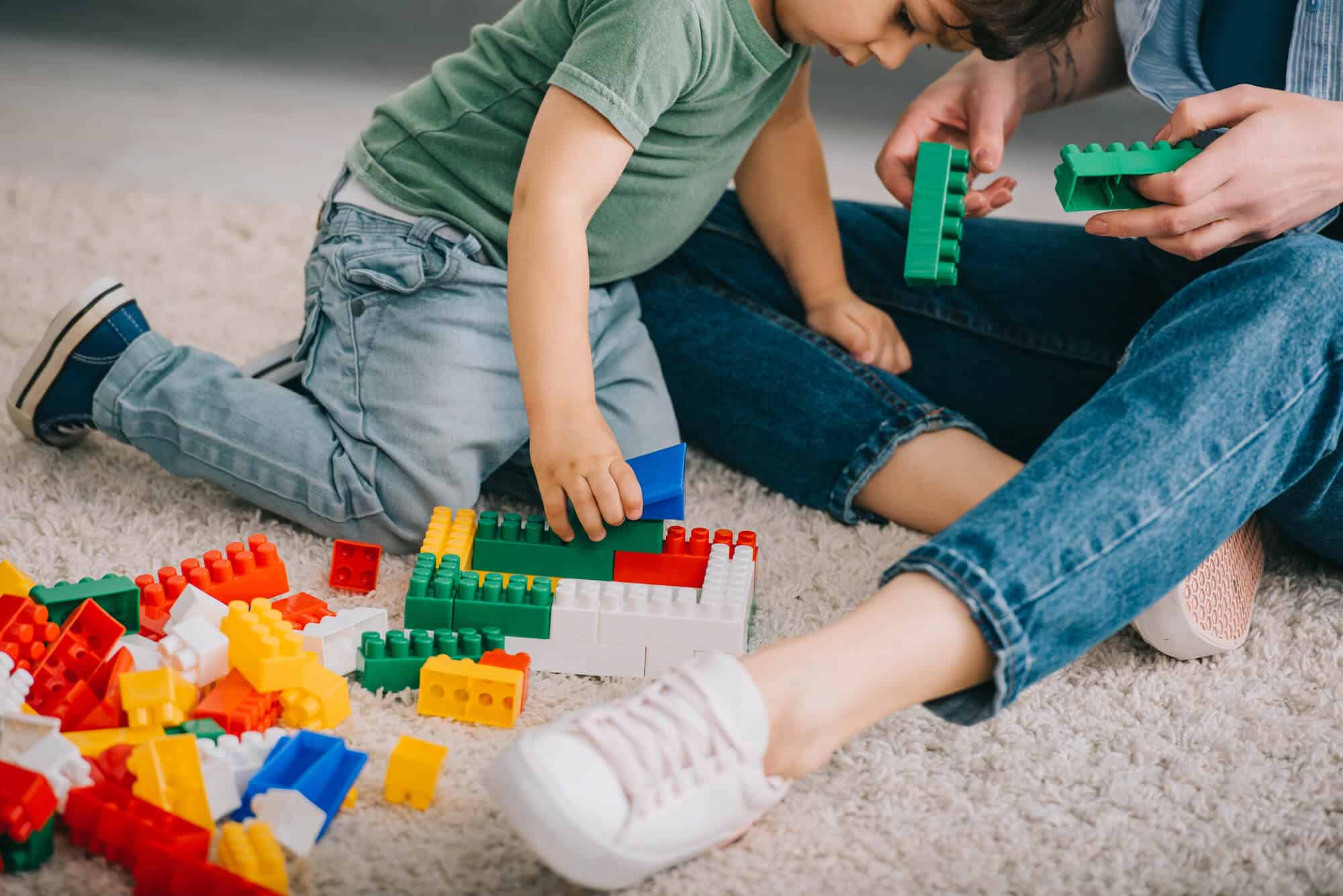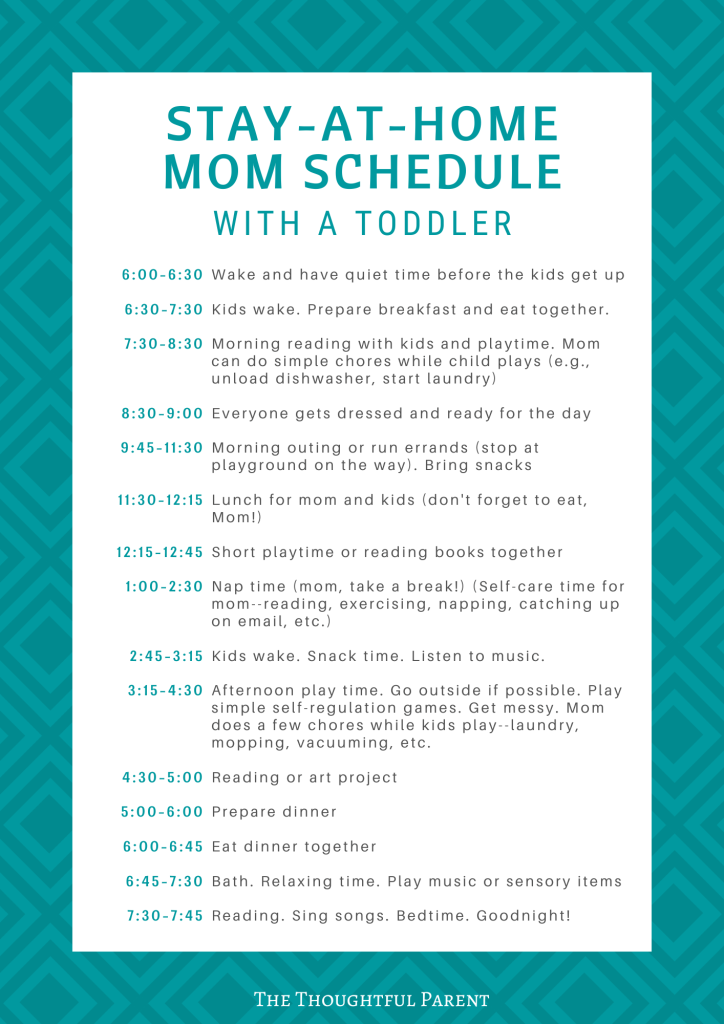Peek inside: Being a stay-at-home mom has its ups and downs. Learn how to establish a stay at home mom schedule for toddlers that works for you and your child.
I sat at the bottom of the basement stairs crying. My husband ran out of his home office, wondering what was going on. He thought our then 2-year-old had gotten injured or sick.
No, it wasn’t that. It was just me. I couldn’t figure out why my toddler was whining and crying endlessly. It wasn’t even 10 o’clock in the morning and I was already emotionally spent. I had thought I might try to get a few minutes on the treadmill, but that’s when the whining started. I tried to console him or play with him, and nothing helped.
Sound familiar? Being a stay-at-home mom is challenging…to say the least.

*This post contains affiliate links. Purchasing through these links provides me a small commission at no added cost to you.
If you are a stay-at-home mom, this is probably something you deal with regularly. Even with the most perfect stay-at-home mom schedule, daily life at home with a toddler can be challenging.
Now, in general, being a mom to a toddler is usually challenging. Whether you’re a stay-at-home mom, work outside the home mom or some combination of both, life with a toddler definitely has a lot of ups and downs. Stay-at-home moms have some unique challenges. We have to somehow figure out how to keep our household running while keeping little hands, heads, and bodies safe from harm and somewhat occupied.
Although I have a degree in Human Development and understand some of the inner workings of a toddler, I still found this stage challenging as a stay-at-home mom. We often forget that, in many ways, toddlers are just “babies on wheels,” meaning they are very mobile but still have very little emotional maturity.
After hearing many stay-at-home moms struggle as I did with this stage, I thought I’d put together a few ideas and lessons learned about establishing a stay-at-home mom schedule for toddlers that help you and your toddler be happy and healthy.
How to be a Happy Stay-at-Home Mom
The core challenge (I think) with being at home with a toddler is the constant pull you feel between needing to watch, engage or entertain your toddler AND the need to get chores done, care for yourself (yes, self-care is a real need for stay-at-home moms), and/or care for a baby. Some days, finding this balance can seem near impossible. For me, the key to being a happy stay-at-home mom was found in finding a little balance between my needs and those of my children.

Tips for Finding Balance as a Stay-at-Home Mom
Connection before chores
We all have our long to-do lists, but finding some time each day to really connect with our kids is crucial. I found that when I got too caught up in getting things marked off my list, my patience ran thin and my children’s behavior seemed to go downhill, too.
One way to prevent this is to spend a few minutes doing something your child wants to do before you start on a big chore or activity that will take your attention away from your child. This helps your child feel connected to you and, many times, helps prevent some meltdowns.
Double duty
Moms are masters of multitasking! While some activities require our full attention and our kids need our full attention much of the time, many activities can serve both our kids’ needs and ours simultaneously. Look for activities that serve dual purposes.
For example, you can go for a walk outside and allow your child to ride his/her tricycle at the same time. You both get exercise and enjoy the activity. Reading really good children’s books can be a form of self-care for you (quiet, calm reading) plus it’s great for your child’s burgeoning language skills. Other dual-purpose activities might be: gardening, listening to music, cooking together or napping.
Set boundaries
It’s often challenging for stay-at-home moms to set boundaries, especially on their time. We feel committed to being with our kids a lot. However, kids (and moms) both benefit from some boundaries. A stay-at-home mom schedule that includes setting aside a period of quiet time each day is one way of setting boundaries in a way that benefits you and your kids.
In terms of a positive parenting approach, the key is to implement boundaries on kids’ behavior, not emotions. For example, if your child is having a meltdown and hitting because you wouldn’t allow him to have another cookie, you can talk to him about how it’s okay to be sad or frustrated, but it’s not okay to hit. This sets a clear boundary on the behavior (hitting) while still allowing the emotion (sadness) to be expressed.
Research shows that, over time, this approach to parenting allows kids to develop better self-regulation skills. You can also offer suggestions for other ways they can calm their emotions, like deep breathing or a calming corner.
Setting boundaries in this way is really a form of self-care for moms. We cannot completely control our children’s behavior, but if we have boundaries in place to allow for our own mental space and allow our kids to learn self-regulation skills, we both benefit.
Check out my signature course for stay-at-home moms!
Set priorities (and let things go)
As stay-at-home moms, we are pulled in many different directions—child care, household care, family organization, kids’ activities, etc. One key I found to setting up a helpful stay-at-home mom schedule for toddlers is to prioritize the things that really matter to you. What things do you value in your child’s development, in your home, in your life? Stick to focusing on those things and allow the other items to fall off the to-do list.
If a perfectly clean house is a top priority for you, that can be a big focus of your day, and you might even get your toddler involved in helping. If doing activities with your kids is a high priority, then the perfectly clean house might have to be lower on the priority list. I think it’s all about trade-off because let’s face it, one mom cannot do everything perfectly. Allow yourself to give up the guilt about not being able to do everything. Focus on your priorities.
Related reading: Research Reveals the Real Reason Why You’re Losing Your Temper with Your Toddler
Activities for Stay-at-Home Moms {that matter to children’s development}
As noted in #4 above, one of the things that helped me find more happiness and meaning in my stay-at-home mom routine was learning what to let go. There might be a mom out there who can simultaneously entertain a toddler, plan a perfect birthday party, cook a nutritious dinner, keep a completely neat house and have time to read a book at night, but that’s NOT me. Being a happy stay-at-home mom (and a sane one) for me meant that I had to be okay with letting some things go. For me, I had to let go of things like having a perfectly orderly house at all times, I had to not stress about events like birthday parties, and not stress about having my kids wear super-adorable, matching outfits.

It’s all about priorities. Whatever your top priorities are for you and your kids, choose to spend time and effort on those and allow the other things to take a back burner.
As a child developmentalist, some of my top priorities for my kids have always been aspects of life that make a difference for their development. There is so much pressure on parents, even stay-at-home moms, to “enrich” our kids’ lives with a huge variety of classes, activities or events. In reality, the stay-at-home mom activities that serve our children’s development most are usually the things we do in the course of an ordinary day. Looking at what we know about children’s development, these are a few things that matter:
Responsiveness
Especially in infancy, but throughout the early years of development, being responsive to our kids’ needs is crucial. In this age of distraction and the constant appeal of screens, this is harder than it seems. Responsiveness in this context means more than just making sure our kids are fed and clothed. In the developmental sense, it means ensuring that we are emotionally available to our kids. This is often harder than meeting their physical needs.
In infancy, responsiveness can mean responding to their cries. As kids mature, responsiveness has more to do with emotional availability and empathy. It might mean not punishing a child’s emotions but helping them gain the skills to cope with those big emotions.
Reading
We all know reading to our kids is important. It boosts their language skills and is a great bonding activity at any age. Beyond just language skills, reading with our kids gives them access to a whole other creative world. By giving them words to describe emotions, big ideas and worries, it gives them their own internal dialogue for understanding the world and their experiences.
Two of my favorite parenting authors describe reading this way,
“When we read to our children, we are not only building these important relational experiences of security and connection, but also the linguistic, cognitive, and conversational abilities that help them participate in something called “co-construction of narrative.” Instead of simply reciting words on a page, the stories we actively read to our children can be part of an ongoing conversation we have with them about events, about life, about the mind, about who we are.”
Need ideas for books for you and your kids? Check out this list: Best Classic Children’s Books (that parents don’t mind reading)
Pretend play
Toddlers love pretend play, and adults often see it as just a cute stage of development in which kids love to imitate. While this is true, pretend play is crucial to children’s early development. Through pretend play, young children learn about their place in the world, how people have different roles, how the world works, and, most importantly, they learn how to interact with other humans in positive ways. The social-emotional skills gained through pretend play are valuable for a lifetime and are difficult to learn any other way.
Related reading: Toddler Toys that Will Boost Children’s Development (and they’ll love for years)
Physical activity
In addition to their emotional development, toddlers are also physically growing at a very rapid rate. If you are a stay-at-home mom, you know that toddlers have A LOT of energy. From a developmental perspective, giving toddlers plenty of opportunities to test their newfound skills in running, climbing (not on the furniture!), skipping, and hopping is an important task. In an era where opportunities for screen time are everywhere, finding ways to help our kids be physically active is more important than ever.
Looking for an example stay-at-home mom schedule for you and your toddler? Click the image below to download this sample schedule (that I used for years).
I also encourage you to support these types of resources by signing up as a paid subscriber (it’s the cost of a cup of fancy coffee:). Paid subscribers get access to a full library of printable resources for families.
Related Resources:
What Being a Stay-at-Home Mom Taught Me About Child Development (that a Ph.D. didn’t!)
Research Reveals the Real Reason You’re Losing Your Temper with Your Toddler






Leave a Reply